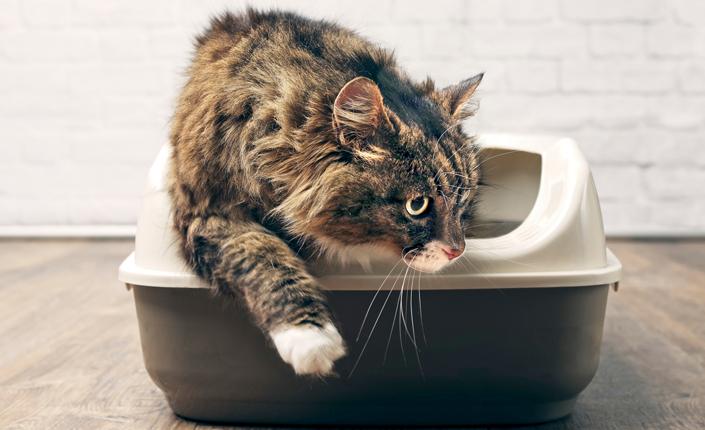
Litter Box Tips: What Your Vet Wants You to Know
House-soiling is one of the top reasons that people surrender or re-home their cats. Cat urine has a strong odour and can be very difficult to clean from your home and furnishings. Urination and defecation outside of the litter box can be triggered by stress, behavioural concerns, medical conditions, and litter box rejection. Cats can be very particular about their litter preferences. Creating a safe and appealing litter box environment is imperative to getting your cat’s bathroom habits back on target, and below are 8 effective tips to get started.
Tip #1: Address or rule out medical concerns regarding why your cat is not using the litter box
There are some serious medical conditions that can trigger house-soiling in cats. Bladder stones, urinary crystals, urinary tract infections, kidney disease, diabetes and arthritis can all cause cats to stop using their litter. Anything that makes using the litter box uncomfortable will lead to house soiling. If you do not address sources of pain, none of the other tips listed here will solve a house-soiling problem. Consult your veterinarian first if your previously tidy cat starts going outside of the box.
Tip #2: Location, location, location!
Cats are particular. Some cats like company when they use the litter, while others prefer privacy. Some like high-traffic areas, and others like seclusion. Household and appliance noises, even subtle ones, can scare a cat out of the litter. Lighting, ventilation, exposure, and proximity to food and bedding are all important aspects to consider, and preferences are unique to each cat. Consider offering a few different options to your cat, especially if they are a new addition to the family, or if you have recently moved.
If your cat has a chronic illness or is getting older, keep in mind that stairs can be a significant barrier between them and the litter box. Make sure each level of your home has bathroom facilities for your cat.
Tip #3: Litter type and depth
Studies suggest that the majority of cats prefer an unscented, clumping clay litter. Other litter types, such as recycled paper, corn husk, wood shavings and even nut shells are available, and may meet your cat’s needs and preferences better. When in doubt, try unscented clumping litter first. Avoid scented litters wherever possible. A cat’s sense of smell is many times more powerful than that of a human. This means that what seems to be a pleasantly perfumed litter for you, can be overpowering and offensive to your cat.
Cats only need a little bit of litter in the box to absorb liquids and provide a substrate for scratching around. Most cats seem to dislike deep litter, so keep the depth to about 1 to 1.5 inches at most.
Tip #4: Litter box structures and options
Litter boxes can come in many varieties. High or low sides, wide or compact, self-cleaning or hooded. Again, each individual cat has their own unique preferences. Larger cats usually need a larger litter box. Some cats can be frightened by the mechanism of a self-cleaning litter box. Some cats with arthritis or mobility issues may need low sides to accommodate easy entry. Other cats may need high sides to contain splashes and sprays. Hooded litter boxes are consistently associated with litter rejection. Imagine choosing between an airy spa bathroom and a cramped port-a-potty. If you prefer to have a hooded litter box, make sure to provide an open option elsewhere in your home. When in doubt, choose a very basic litter pan with moderate depth.
Tip #5: Multiple cats means multiple litter boxes
Cat-to-cat communication can be subtle, and difficult for owners to interpret. Even the friendliest cats are competitive with each-other and may guard resources or bully each other. Inter-cat competition, aggression and stress are a significant factor in house soiling. Make sure to provide one litter box for every cat in the household, plus one extra one. Place them in various locations, and make sure each location has an “escape route.” Consider installing calm-inducing pheromone diffusers near litter boxes.
Tip #6: Keep a regular cleaning schedule
Remember, cats are extremely sensitive to smell, and many cats will reject litter boxes that are anything other than pristine. This is especially true if you have multiple cats in your home. A general rule of thumb is to scoop feces and clumps daily, replace all the litter twice weekly and wash the box with soap and water once weekly. If you have multiple cats, or if you are experiencing house-soiling, increase the cleaning frequency.
Tip #7: Cleaning accidents thoroughly and promptly
When cleaning up after a house-soiling event, it is important to use an enzymatic cleaner. Standard household cleaners may remove the stains and odours that are perceived by you, but a cat’s nose can still detect the mess. Cats tend to return to areas that have been soiled before. Only enzymatic cleaners will break down the scent molecules so that the mess is no longer detected by a cat. These cleaners can be found in pet supply stores, vet’s offices, and online. If your cat is returning to a particular area time after time, try putting a litter box right on top of the freshly cleaned spot. Sure, it may be inconvenient to have a litter box at your front door, but after a few weeks of good target practice, you can slowly start migrating the box to a more acceptable spot.
Tip #8: Litter attractants and pheromones
Making the litter experience a good one for cats is key to preventing house soiling. When your cat gets off track with litter box use, changing the location, the litter type, and the box design are the first adjustments to make. Sometimes, it takes just a little bit more incentive to try out the new loo. Litter attractants are typically a mixture of appealing dried herbs that you can sprinkle on the litter. The gentle, pleasing smell of the additive encourages cats to use the litter rather than other areas.
As mentioned, tensions between cats can lead to elimination in inappropriate areas. Synthetic pheromone diffusers can help to create a relaxed atmosphere and ease inter-cat aggression. These pheromones, not detectible to human noses, simulate the pheromones released by cats when they rub their mouths and chins on objects and each other. They make cats feel calm and happy, improve cat-cat relationships, and increase the likelihood of proper litter use.
House-soiling in cats is not an irreversible problem. Ruling out medical concerns and making some inexpensive adjustments to your cat’s bathroom design can make a world of difference, and put messes in the past forever.
Written by: Dr. Sperry, DVM, Veterinary Advisor, Pets Plus Us
The information provided and contained herein are the opinions of PTZ Insurance Services Ltd. which are based on external publication. The content is not intended to be a substitute for professional veterinary advice. PTZ Insurance Services Ltd. assumes no responsibility or liability for any loss, claims or damages arising out of the within content.
